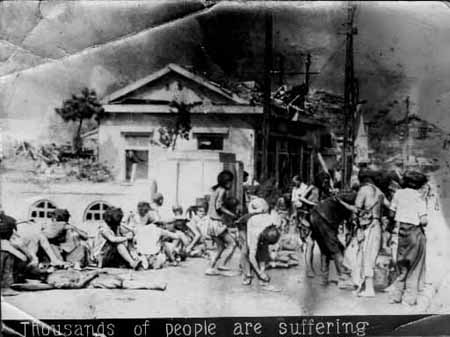Newly-found copy of a well-known A-bomb photo reveals disturbing detail
May 1, 2008
Another copy of one of the most well-known A-bomb photographs has been found at Hiroshima Peace Memorial Hall. The image was the first of five photos taken on August 6, 1945 by Yoshito Matsushige, who died in 2005 at the age of 92. In the newly-discovered copy, a man, whose body was severely burned and was most likely dead, can clearly be seen. However, the figure of this man is not recognizable in other copies of this photograph due to scratches on the negative or other factors.
A curator at the museum found two duplicates of this image while sorting through over 3,000 A-bomb related photos that had been donated or entrusted to the museum. One of these copies has a printed caption at the bottom which reads “Thousands of people are suffering.”
The photo was taken at the west end of Miyuki Bridge, located 2.2 kilometers southeast of the hypocenter, and reveals a man lying on the street with his legs stretched out, his clothes almost completely burned away. It first appeared in the Chugoku Shimbun's evening edition of July 6, 1946.
The copy with the English caption was donated to the museum in 1970. There is no record as to how the person who donated the photo came into its possession. The same is true for the other duplicate.
In an interview with museum staff, Mr. Matsushige, a former photographer for the Chugoku Shimbun, had remarked, “I exchanged some photos with a colleague in the chaotic period after the war. But then my photos began to be distributed against my will and so I asked that they be returned to me.” The newly-found copies seem to have been duplicated and sold as a memento of Hiroshima.
Mr. Matsushige was exposed to the bombing at his home in Hiroshima, but he started taking photos about three hours after the blast and captured five images which depict the terrible devastation of that day. No other photos were taken in the immediate aftermath of the bombing inside the city.
The same photo was included in a collection issued by a Tokyo publisher in 1952 after the U.S. occupation ended and, over the years, has appeared widely both in Japan and abroad. However, due to scratches to the negative, or deliberate alteration, the image of the man was rendered unrecognizable.
A curator at the museum found two duplicates of this image while sorting through over 3,000 A-bomb related photos that had been donated or entrusted to the museum. One of these copies has a printed caption at the bottom which reads “Thousands of people are suffering.”
The photo was taken at the west end of Miyuki Bridge, located 2.2 kilometers southeast of the hypocenter, and reveals a man lying on the street with his legs stretched out, his clothes almost completely burned away. It first appeared in the Chugoku Shimbun's evening edition of July 6, 1946.
The copy with the English caption was donated to the museum in 1970. There is no record as to how the person who donated the photo came into its possession. The same is true for the other duplicate.
In an interview with museum staff, Mr. Matsushige, a former photographer for the Chugoku Shimbun, had remarked, “I exchanged some photos with a colleague in the chaotic period after the war. But then my photos began to be distributed against my will and so I asked that they be returned to me.” The newly-found copies seem to have been duplicated and sold as a memento of Hiroshima.
Mr. Matsushige was exposed to the bombing at his home in Hiroshima, but he started taking photos about three hours after the blast and captured five images which depict the terrible devastation of that day. No other photos were taken in the immediate aftermath of the bombing inside the city.
The same photo was included in a collection issued by a Tokyo publisher in 1952 after the U.S. occupation ended and, over the years, has appeared widely both in Japan and abroad. However, due to scratches to the negative, or deliberate alteration, the image of the man was rendered unrecognizable.








